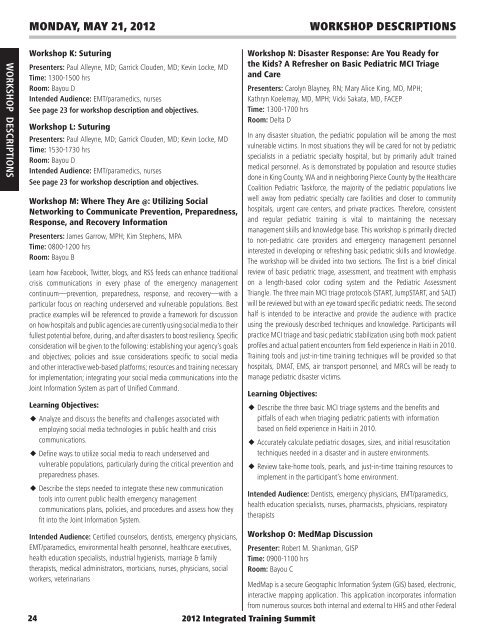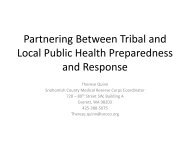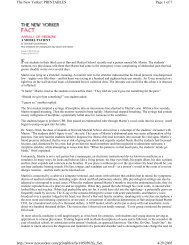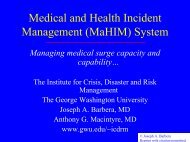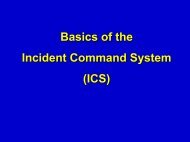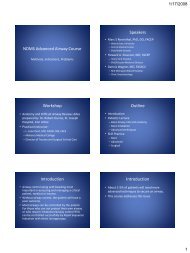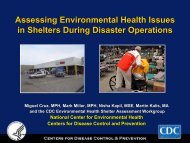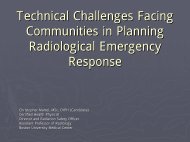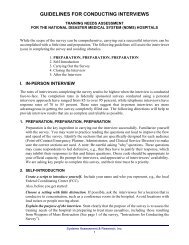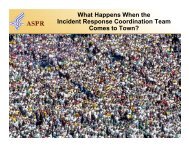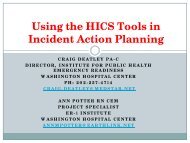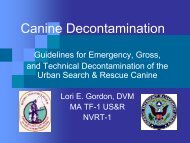MoNday, May 21, <strong>2012</strong>Workshop DescriptionsWorkshop DescriptionsWorkshop K: SuturingPresenters: Paul Alleyne, MD; Garrick Clouden, MD; Kevin Locke, MDTime: 1300-1500 hrsRoom: Bayou DIntended Audience: EMT/paramedics, nursesSee page 23 for workshop description and objectives.Workshop L: SuturingPresenters: Paul Alleyne, MD; Garrick Clouden, MD; Kevin Locke, MDTime: 1530-1730 hrsRoom: Bayou DIntended Audience: EMT/paramedics, nursesSee page 23 for workshop description and objectives.Workshop M: Where <strong>The</strong>y Are @: Utilizing SocialNetworking to Communicate Prevention, <strong>Preparedness</strong>,Response, and <strong>Recovery</strong> InformationPresenters: James Garrow, MPH; Kim Stephens, MPATime: 0800-1200 hrsRoom: Bayou BLearn how Facebook, Twitter, blogs, and RSS feeds can enhance traditionalcrisis communications in every phase of the emergency managementcontinuum—prevention, preparedness, response, and recovery—with aparticular focus on reaching underserved and vulnerable populations. Bestpractice examples will be referenced to provide a framework for discussionon how hospitals and public agencies are currently using social media to theirfullest potential before, during, and after disasters to boost resiliency. Specificconsideration will be given to the following: establishing your agency’s goalsand objectives; policies and issue considerations specific to social mediaand other interactive web-based platforms; resources and training necessaryfor implementation; integrating your social media communications into theJoint Information System as part of Unified Command.Learning Objectives:u Analyze and discuss the benefits and challenges associated withemploying social media technologies in public health and crisiscommunications.u Define ways to utilize social media to reach underserved andvulnerable populations, particularly during the critical prevention andpreparedness phases.u Describe the steps needed to integrate these new communicationtools into current public health emergency managementcommunications plans, policies, and procedures and assess how theyfit into the Joint Information System.Intended Audience: Certified counselors, dentists, emergency physicians,EMT/paramedics, environmental health personnel, healthcare executives,health education specialists, industrial hygienists, marriage & familytherapists, medical administrators, morticians, nurses, physicians, socialworkers, veterinarians24Workshop N: Disaster Response: Are You Ready forthe Kids? A Refresher on Basic Pediatric MCI Triageand CarePresenters: Carolyn Blayney, RN; Mary Alice King, MD, MPH;Kathryn Koelemay, MD, MPH; Vicki Sakata, MD, FACEPTime: 1300-1700 hrsRoom: Delta DIn any disaster situation, the pediatric population will be among the mostvulnerable victims. In most situations they will be cared for not by pediatricspecialists in a pediatric specialty hospital, but by primarily adult trainedmedical personnel. As is demonstrated by population and resource studiesdone in King County, WA and in neighboring Pierce County by the HealthcareCoalition Pediatric Taskforce, the majority of the pediatric populations livewell away <strong>from</strong> pediatric specialty care facilities and closer to communityhospitals, urgent care centers, and private practices. <strong>The</strong>refore, consistentand regular pediatric training is vital to maintaining the necessarymanagement skills and knowledge base. This workshop is primarily directedto non-pediatric care providers and emergency management personnelinterested in developing or refreshing basic pediatric skills and knowledge.<strong>The</strong> workshop will be divided into two sections. <strong>The</strong> first is a brief clinicalreview of basic pediatric triage, assessment, and treatment with emphasison a length-based color coding system and the Pediatric AssessmentTriangle. <strong>The</strong> three main MCI triage protocols (START, JumpSTART, and SALT)will be reviewed but with an eye toward specific pediatric needs. <strong>The</strong> secondhalf is intended to be interactive and provide the audience with practiceusing the previously described techniques and knowledge. Participants willpractice MCI triage and basic pediatric stabilization using both mock patientprofiles and actual patient encounters <strong>from</strong> field experience in Haiti in 2010.Training tools and just-in-time training techniques will be provided so thathospitals, DMAT, EMS, air transport personnel, and MRCs will be ready tomanage pediatric disaster victims.Learning Objectives:u Describe the three basic MCI triage systems and the benefits andpitfalls of each when triaging pediatric patients with informationbased on field experience in Haiti in 2010.u Accurately calculate pediatric dosages, sizes, and initial resuscitationtechniques needed in a disaster and in austere environments.u Review take-home tools, pearls, and just-in-time training resources toimplement in the participant’s home environment.Intended Audience: Dentists, emergency physicians, EMT/paramedics,health education specialists, nurses, pharmacists, physicians, respiratorytherapistsWorkshop O: MedMap DiscussionPresenter: Robert M. Shankman, GISPTime: 0900-1100 hrsRoom: Bayou CMedMap is a secure Geographic Information System (GIS) based, electronic,interactive mapping application. This application incorporates information<strong>from</strong> numerous sources both internal and external to HHS and other Federal<strong>2012</strong> Integrated Training Summit
MoNday, May 21, <strong>2012</strong>Workshop Descriptionsand public agencies into a single visual environment for enhanced situationalawareness, assessment, and management of resources for planning as wellas for response to a natural, man-made, or pandemic event. This systemsupports functions such as policy analysis, planning, course of actioncomparison, incident management, and training. It supports the needs ofdecision makers at various levels of management within HHS and otherFederal agencies to provide enhanced situational awareness at a levelof granularity needed for all responders, including regional emergencycoordinators and teams in the field. It is also able to display and providedetails on medical care sites, resources, and mobilization points and provideanalytical tools for planning and preparedness efforts. During a large eventsuch as an improvised explosive device (IED) or hurricane, there is the needto immediately determine medical care sites, resources, and mobilizationpoints and modify needed data as it becomes available and changes.Rapidly changing conditions and the need for a large regional and nationalresponse require extensive preplanning and a highly flexible system as wellas the ability for data <strong>from</strong> the field to seamlessly get to leadership removed<strong>from</strong> the scene and aid in the planning of the event’s response. MedMap isable to display many different datasets and data feeds, including local datafeeds, to help all involved work with a more complete aggregation of data.With a fully customizable interface, individual users are able to define thedata layers that they need for a specific event or need. Accounts to accessMedMap are created on an individual basis (no group access accounts).External user accounts will become available in the first quarter of 2011.Learning Objectives:u Access the application and utilize the tools within MedMap.u Explain how to add and display data within the interface, while alsobeing able to perform simple spatial analysis.u Demonstrate how to export tables, PDF maps, and JPGs for useoutside of MedMap.Intended Audience: Certified counselors, dentists, emergency physicians,EMT/paramedics, environmental health personnel, healthcare executives,health education specialists, industrial hygienists, marriage & familytherapists, medical administrators, morticians, nurses, physicians, socialworkers, veterinariansWorkshop P: MedMap Hands-OnPresenter: Robert M. Shankman, GISPTime: 1300-1500 hrsRoom: Bayou C<strong>The</strong>re is no fee to attend this two-hour discussion/workshop. Space islimited! This workshop will be a hands-on demonstration of the MedMapand will complement the 0900-1100 hrs discussion. You may register forboth sessions.MedMap is a secure Geographic Information System (GIS) based, electronic,interactive mapping application. This application incorporates information<strong>from</strong> numerous sources both internal and external to HHS and other Federaland public agencies into a single visual environment for enhanced situationalawareness, assessment, and management of resources for planning as wellas for response to a natural, man-made, or pandemic event. This systemsupports functions such as policy analysis, planning, course of actioncomparison, incident management, and training. It supports the needs ofdecision makers at various levels of management within HHS and otherFederal agencies to provide enhanced situational awareness at a levelof granularity needed for all responders, including regional emergencycoordinators and teams in the field. It is also able to display and providedetails on medical care sites, resources, and mobilization points and provideanalytical tools for planning and preparedness efforts. During a large eventsuch as an improvised explosive device (IED) or hurricane, there is the needto immediately determine medical care sites, resources, and mobilizationpoints and modify needed data as it becomes available and changes.Rapidly changing conditions and the need for a large regional and nationalresponse requires extensive preplanning and a highly flexible system as wellas the ability for data <strong>from</strong> the field to seamlessly get to leadership removed<strong>from</strong> the scene and aid in the planning of the event’s response. MedMap isable to display many different datasets and data feeds, including local datafeeds, to help all involved work with a more complete aggregation of data.With a fully customizable interface, individual users are able to define thedata layers that they need for a specific event or need. Accounts to accessMedMap are created on an individual basis (no group access accounts).External user accounts will become available in the first quarter of 2011.Learning Objectives:u Access the application and utilize the tools within MedMap.u Explain how to add and display data within the interface, while alsobeing able to perform simple spatial analysis.u Demonstrate how to export tables, PDF maps, and JPGs for useoutside of MedMap.Workshop X: Mass Casualty Incident ManagementPresenter: A.J. Heightman, MPA, EMT-PTime: 0800-1700 hrs(16 hour course, continues Tuesday, May 22, 0800-1700 hrs)Room: Governor’s BThis workshop is designed for anyone involved in delivering emergencyservices as a result of a mass casualty incident (MCI). A community’s EMS,fire, rescue, police, aeromedical, fire-police, emergency department, anddispatch center personnel should attend since joint response and coordination<strong>2012</strong> Integrated Training Summit 25Workshop Descriptions
- Page 1 and 2: Leading from PreparednessThrough Re
- Page 3 and 4: Table of ContentsAmericans with Dis
- Page 5 and 6: Integrated Training Summit Partner
- Page 7 and 8: Focus area DescriptionsFocus Area D
- Page 9 and 10: Late Breakers & Early RisersTuesday
- Page 11 and 12: Handy Perforated Daily Agendas - De
- Page 13 and 14: Handy Perforated Daily Agendas - De
- Page 15 and 16: Handy Perforated Daily Agendas - De
- Page 17 and 18: Handy Perforated Daily Agendas - De
- Page 19 and 20: WorkshopDescriptions2012 Integrated
- Page 21 and 22: Monday, May 21, 2012Workshop Descri
- Page 23: MoNday, May 21, 2012Workshop Descri
- Page 27 and 28: Tuesday, May 22, 2012Workshop Descr
- Page 29 and 30: WEDNESday, May 23, 2012dMIS Worksho
- Page 31 and 32: ThurSday, May 23, 2012dMIS Workshop
- Page 33 and 34: SessionDescriptionssession Descript
- Page 35 and 36: wednesday, May 23, 2012Session Desc
- Page 37 and 38: wednesday, May 23, 2012Session Desc
- Page 39 and 40: wednesday, May 23, 2012u Provide ex
- Page 41 and 42: wednesday, May 23, 2012Session Desc
- Page 43 and 44: wednesday, May 23, 2012Session Desc
- Page 45 and 46: Thursday, May 24, 2012Session Descr
- Page 47 and 48: THURsday, May 24, 2012Session Descr
- Page 49 and 50: THURsday, May 24, 2012Session Descr
- Page 51 and 52: THURsday, May 24, 2012Session Descr
- Page 53 and 54: THURsday, May 24, 2012Session Descr
- Page 55 and 56: THURsday, May 24, 2012Session Descr
- Page 57 and 58: FRIday, May 25, 2012Session Descrip
- Page 59 and 60: Tuesday, May 22, 2012MRC WorkshopsM
- Page 61 and 62: Tuesday, May 22, 2012MRC WorkshopsL
- Page 63 and 64: Continuing Education InformationCon
- Page 65 and 66: Continuing Education InformationSes
- Page 67 and 68: Planning CommitteeDawn AnastasiaChe
- Page 69 and 70: PresentersBrian Abrahamson, BAGaylo
- Page 71 and 72: PresentersMary Massey, BSN, MA, MEP
- Page 73 and 74: Presenter DisclosuresAlliance betwe
- Page 75 and 76:
2012 Poster PresentationsMRCPoster
- Page 77 and 78:
2012 Poster PresentationsApplicatio
- Page 79 and 80:
2012 Poster PresentationsCollaborat
- Page 81 and 82:
2012 Poster PresentationsEducation
- Page 83 and 84:
2012 Poster PresentationsSpecial Co
- Page 85 and 86:
Integrated Training Summit Acronym


